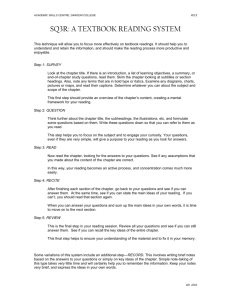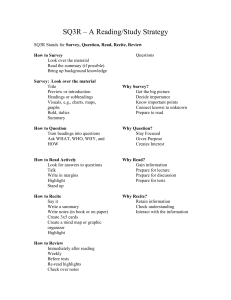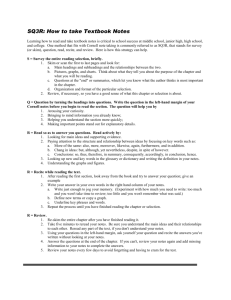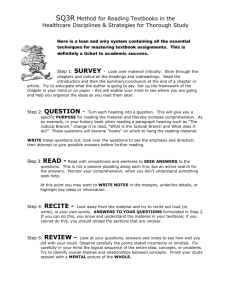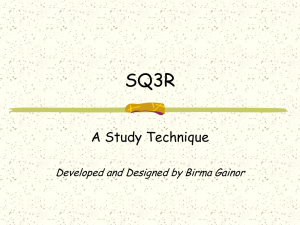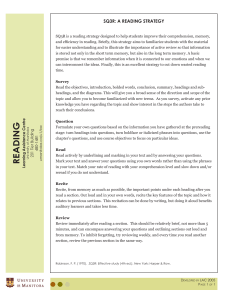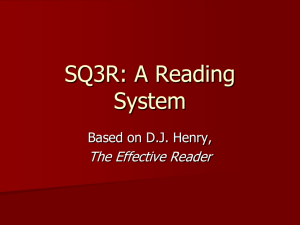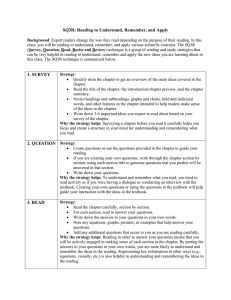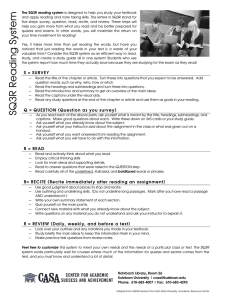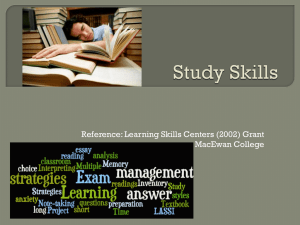SQ3R
advertisement
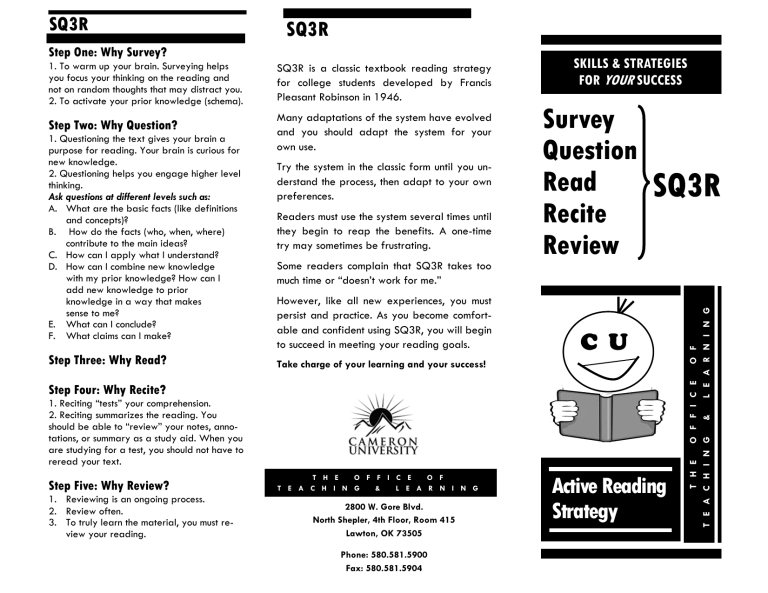
SQ3R Step One: Why Survey? 1. To warm up your brain. Surveying helps you focus your thinking on the reading and not on random thoughts that may distract you. 2. To activate your prior knowledge (schema). Step Two: Why Question? 1. Questioning the text gives your brain a purpose for reading. Your brain is curious for new knowledge. 2. Questioning helps you engage higher level thinking. Ask questions at different levels such as: A. What are the basic facts (like definitions and concepts)? B. How do the facts (who, when, where) contribute to the main ideas? C. How can I apply what I understand? D. How can I combine new knowledge with my prior knowledge? How can I add new knowledge to prior knowledge in a way that makes sense to me? E. What can I conclude? F. What claims can I make? Step Three: Why Read? SQ3R is a classic textbook reading strategy for college students developed by Francis Pleasant Robinson in 1946. Many adaptations of the system have evolved and you should adapt the system for your own use. Try the system in the classic form until you understand the process, then adapt to your own preferences. Readers must use the system several times until they begin to reap the benefits. A one-time try may sometimes be frustrating. SKILLS & STRATEGIES FOR YOUR SUCCESS Survey Question Read Recite Review SQ3R Some readers complain that SQ3R takes too much time or “doesn’t work for me.” However, like all new experiences, you must persist and practice. As you become comfortable and confident using SQ3R, you will begin to succeed in meeting your reading goals. C U Take charge of your learning and your success! Step Four: Why Recite? 1. Reciting “tests” your comprehension. 2. Reciting summarizes the reading. You should be able to “review” your notes, annotations, or summary as a study aid. When you are studying for a test, you should not have to reread your text. Step Five: Why Review? 1. Reviewing is an ongoing process. 2. Review often. 3. To truly learn the material, you must review your reading. T H E O F F I C E O F T E A C H I N G & L E A R N I N G 2800 W. Gore Blvd. North Shepler, 4th Floor, Room 415 Lawton, OK 73505 Phone: 580.581.5900 Fax: 580.581.5904 Active Reading Strategy O F O F F I C E T H E L E A R N I N G & T E A C H I N G SQ3R Step 1: SURVEY Use the this Page from The Confident Student to Practice Step 4: RECITE How to Survey: 1. Skim through the reading assignment. (this step is sometimes called wRite or Recall) 3. Notice the organization of the text. Ways to Recite: 1. Stop and attempt to summarize what you have read. Look away from the text and summarize. Out loud, in your own words, summarize. If you think, “I understand it; I just can’t put it into words,” you really don’t understand. Read again. 4. Read headings and subheadings. 2. Answer the questions you formed. 5. Read bold words. 3. Annotate the text. Underline, highlight, write notes in the margin, and have a “conversation” with the text. Most readers need to read through the text before annotating. Too often, readers highlight or underline too much material. Read, then annotate. 2. Try using your finger as a guide as you skim. 6. Look at graphs, photographs, photographs, and other illustrations. 7. Think about what you already know about the reading. 3. Answer the questions that you formed. 4. Outline the text. Step 2: QUESTION 5. Create notes using a note-taking strategy such as Cornell Notes, visual notes, a graphic organizer, or flashcards. How to Question: 1. If your textbook, textbook supplements, or instructor provides questions, read through them. Avoid reading answers since the distracters may divert your thinking. 2. Form questions by turning headings and subheadings into questions. Write directly in your text, use Post -Its, or write in your notebook. For example: The main heading for the reading selection is: “The Reading and Study Connection.” The question might become: “How are reading and study connected?” or “How can I apply my reading skills to my study skills? Step 5: REVIEW Step 3: READ 1. “Chunk” or divide the reading into sections. 2. Read the text, varying your reading rate based on text complexity. 3. As you read, look for organizational patterns. A. Does the textbook define or describe a theory, then give illustrations or examples? B. Look for the main topic and the supporting topics. What’s the main point? Ways to Review: 1. Within twenty-four hours, go over your notes, annotations, or summary. Revise as needed. 2. Rewrite notes as needed. 3. Review again at least once a week. Periodic, consistent review helps you learn the material on a deeper level. You will commit knowledge to your long term memory.
